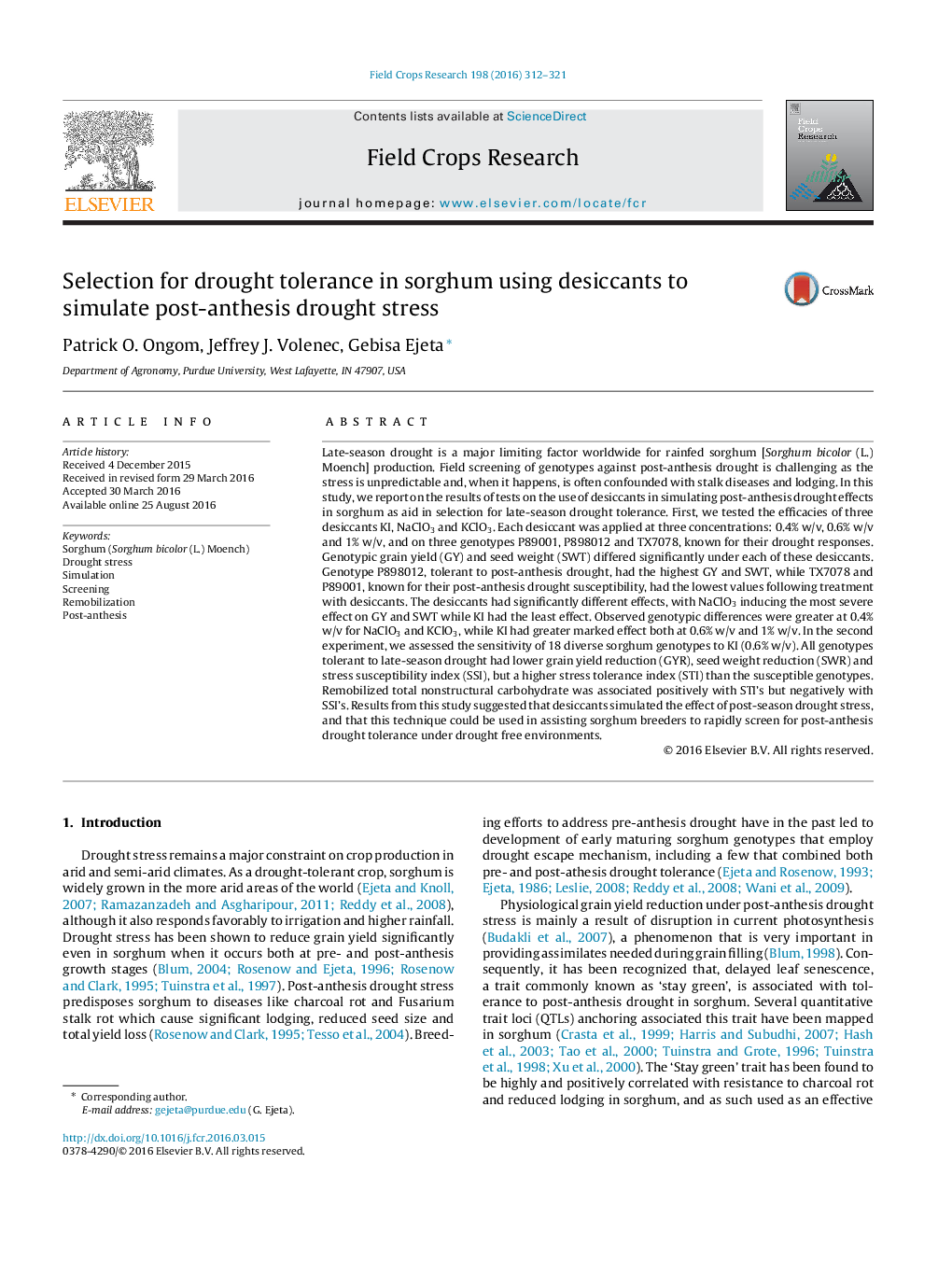| کد مقاله | کد نشریه | سال انتشار | مقاله انگلیسی | نسخه تمام متن |
|---|---|---|---|---|
| 6374418 | 1624665 | 2016 | 10 صفحه PDF | دانلود رایگان |
- Effectiveness of different chemical desiccants in imposing post-anthesis drought-like stress on sorghum genotypes differed significantly. NaClO3 induced the most severe effect on grain yield and seed weigh followed by KClO3 while KI had the least effect.
- Chemical desiccation stress was able to clearly separate between known late-season drought tolerant and susceptible sorghum genotypes, with reactions matching well the known post-flowering drought stress resistance of the genotypes.
- Higher genotypic tolerance to chemical desiccation stress, measured by stress tolerance indices (STI's) corresponded well with lesser reduction in grain yield and one hundred seed weight.
- Remobilized total nonstructural carbohydrate (RTNC) was associated positively with stress STI's but negatively with stress susceptibility indices (SSI's). RTNC concentration explained more than 40% of variation in tolerance levels of genotypes.
- Chemical desiccation stress appeared to closely simulate the effect of post-anthesis drought stress, revealing the possibility of using desiccants in rapid selection of sorghum genotypes for post-anthesis drought tolerance.-
Late-season drought is a major limiting factor worldwide for rainfed sorghum [Sorghum bicolor (L.) Moench] production. Field screening of genotypes against post-anthesis drought is challenging as the stress is unpredictable and, when it happens, is often confounded with stalk diseases and lodging. In this study, we report on the results of tests on the use of desiccants in simulating post-anthesis drought effects in sorghum as aid in selection for late-season drought tolerance. First, we tested the efficacies of three desiccants KI, NaClO3 and KClO3. Each desiccant was applied at three concentrations: 0.4% w/v, 0.6% w/v and 1% w/v, and on three genotypes P89001, P898012 and TX7078, known for their drought responses. Genotypic grain yield (GY) and seed weight (SWT) differed significantly under each of these desiccants. Genotype P898012, tolerant to post-anthesis drought, had the highest GY and SWT, while TX7078 and P89001, known for their post-anthesis drought susceptibility, had the lowest values following treatment with desiccants. The desiccants had significantly different effects, with NaClO3 inducing the most severe effect on GY and SWT while KI had the least effect. Observed genotypic differences were greater at 0.4% w/v for NaClO3 and KClO3, while KI had greater marked effect both at 0.6% w/v and 1% w/v. In the second experiment, we assessed the sensitivity of 18 diverse sorghum genotypes to KI (0.6% w/v). All genotypes tolerant to late-season drought had lower grain yield reduction (GYR), seed weight reduction (SWR) and stress susceptibility index (SSI), but a higher stress tolerance index (STI) than the susceptible genotypes. Remobilized total nonstructural carbohydrate was associated positively with STI's but negatively with SSI's. Results from this study suggested that desiccants simulated the effect of post-season drought stress, and that this technique could be used in assisting sorghum breeders to rapidly screen for post-anthesis drought tolerance under drought free environments.
Journal: Field Crops Research - Volume 198, November 2016, Pages 312-321
